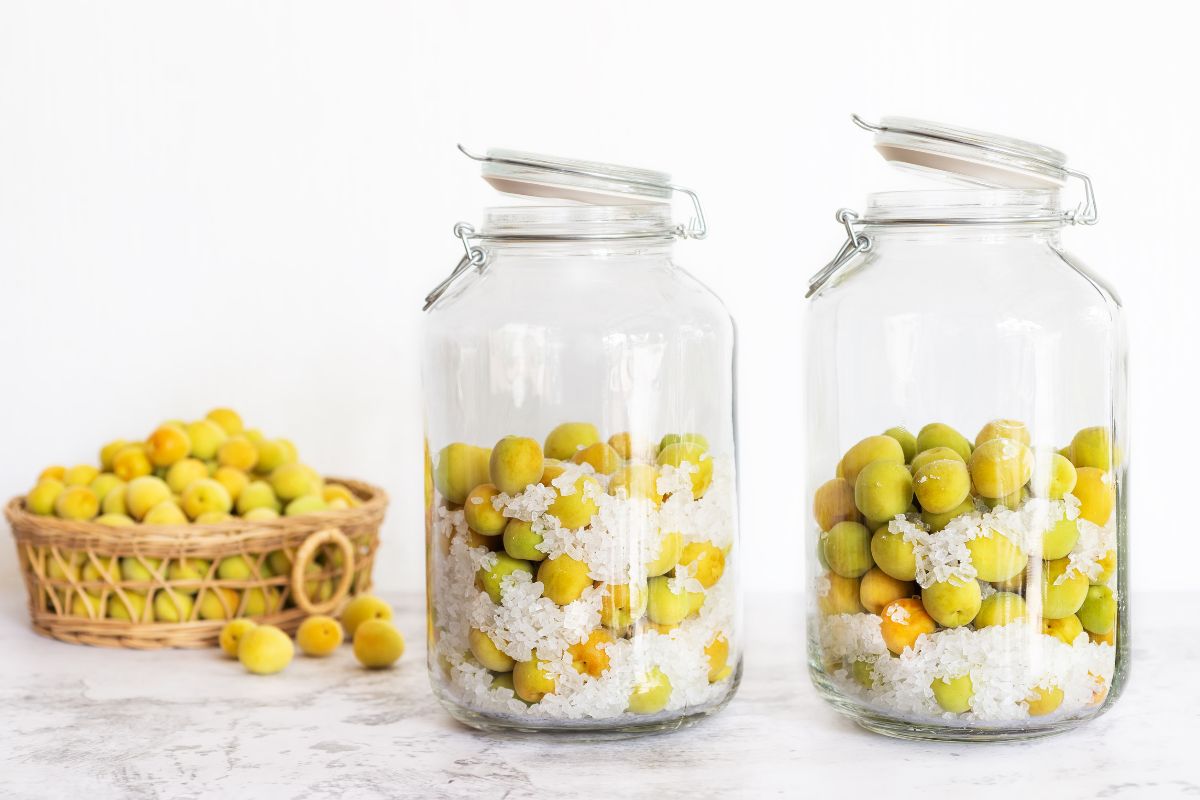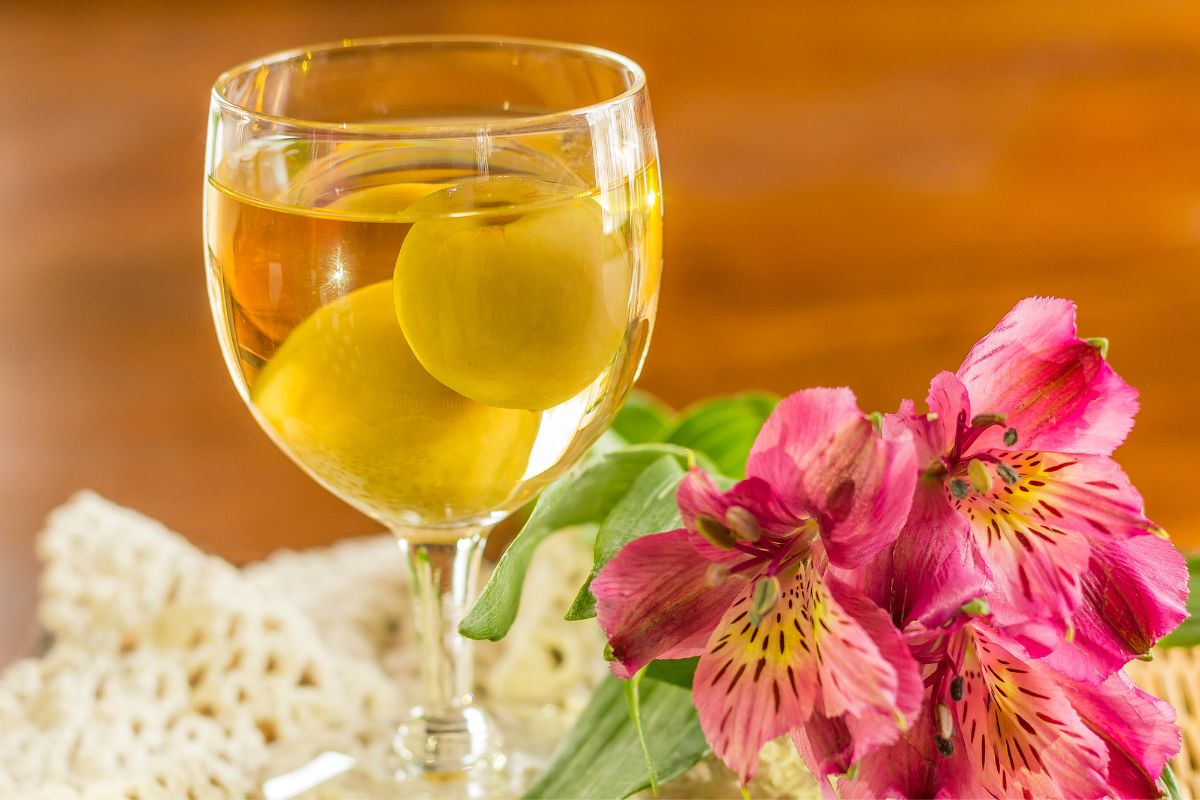Plum wine, also known as umeshu, is a delightful and aromatic beverage that has been enjoyed for centuries in various cultures.
Made from the fermentation of plums, sugar, and alcohol, plum wine offers a sweet and tangy flavor profile that is both refreshing and satisfying.

Plum wine has its roots in East Asia, particularly in countries like Japan, China, and Korea. It is often made using a specific type of plum called the Japanese plum, or ume.
However, variations of plum wine can be found in different parts of the world, utilizing local plum varieties and regional winemaking techniques.
In this simple guide to plum wine, we will be diving into everything you need to know, including the history of the drink and how to go about creating your own take on the beverage.
So, let’s embark on this journey into the world of plum wine and unlock the secrets of this ancient and delightful libation!
The History Of Plum Wine
The history of plum wine can be traced back thousands of years, with its origins deeply rooted in East Asia.
Plum wine, or umeshu as it is known in Japanese, has a rich cultural heritage and has been enjoyed as a traditional beverage in countries such as Japan, China, and Korea.
In Japan, plum wine holds a significant place in the country’s history and cultural traditions. The production and consumption of plum wine date back to the Nara period (710-794), when it was initially used for medicinal purposes.
It was believed to have health benefits and was used as a digestive aid and a remedy for various ailments.
Over time, plum wine transitioned from being purely medicinal to a popular beverage enjoyed for its taste and refreshing qualities.
It became a staple during special occasions, festivals, and family celebrations, and it holds a symbolic significance in Japanese culture.
Plum wine also has a long history in China, where the tradition of making plum wine dates back to ancient times, often associated with the elite class and the literati.
Plum wine was enjoyed during social gatherings in ancient China and was considered a sophisticated and refined drink.
In Korea, plum wine, known as maesilju, has also been a part of the country’s cultural heritage for centuries. It is made using green or yellow plums with sugar, and alcohol, and is often consumed as a dessert wine or an apéritif.
Throughout history, plum wine has been made using various traditional methods and recipes, passed down through generations.
The process typically involves steeping ripe plums in alcohol, such as sake or shochu, along with sugar or honey, and allowing the flavors to meld over time through a process of fermentation and aging.
In recent years, plum wine has gained popularity beyond its traditional Asian roots and has become appreciated by wine enthusiasts worldwide.
Craft breweries and wineries in different parts of the world have embraced the art of making plum wine, often using local plum varieties and putting their unique spin on the process.
Today, plum wine is enjoyed for its sweet and tangy flavor profile, aromatic qualities, and versatility. It can be sipped on its own, mixed into cocktails, or used as a flavorful ingredient in various culinary creations.
Its rich history and cultural significance make plum wine not just a delightful beverage, but also a window into the traditions and flavors of East Asian cultures.
How Is Plum Wine Made?
Plum wine is made through a relatively straightforward process that involves steeping ripe plums in alcohol and allowing the flavors to infuse over time. Let’s check out a general step-by-step guide on how to make plum wine.
Ingredient Preparation
Select ripe plums, preferably Japanese plums (ume) or any other plum variety suitable for winemaking.
Wash the plums thoroughly and remove any stems or leaves. Prick each plum with a fork or toothpick to aid in flavor extraction.
Sterilization
Ensure that all equipment, such as fermentation vessels, jars, and utensils, is properly cleaned and sterilized to prevent unwanted microbial growth during the fermentation process.
This step is crucial to maintain the quality and safety of the wine.
Plum And Sugar Layering
In a large glass jar or fermentation vessel, layer the plums and sugar. Start with a layer of plums at the bottom, followed by a layer of sugar.
Repeat this process until all the plums and sugar are used. The amount of sugar used can vary based on personal preference and desired sweetness.
Adding Alcohol
Pour alcohol into the jar, covering the plum and sugar layers completely. Traditionally, plum wine is made with clear distilled spirits such as sake, shochu, or vodka.
The alcohol content should be at least 30% to ensure proper preservation and extraction of flavors. The plums should be fully submerged in the alcohol.
Fermentation And Aging
Seal the jar tightly and store it in a cool, dark place away from direct sunlight. Allow the mixture to ferment and age for several months to a year.
During this time, the flavors of the plums infuse into the alcohol, creating a rich and aromatic wine. It is recommended to periodically shake or gently agitate the jar to help distribute the flavors.
Straining And Bottling
After the desired fermentation and aging period, strain the plum wine using a fine-mesh sieve or cheesecloth to remove the plum solids and any sediment.
Transfer the strained liquid into clean, sterilized bottles for storage. It is advisable to let the plum wine mature further in the bottles for a few months to allow the flavors to develop and mellow.
Serve It Up And Enjoy!
Plum wine can be served chilled or at room temperature. It is often enjoyed as a dessert wine or apéritif, and it pairs well with a variety of dishes, both sweet and savory.
The sweetness and tanginess of the wine make it a refreshing and delightful beverage.
Remember, the specific measurements and techniques may vary depending on the recipe and personal preferences.
It is always a good idea to follow a trusted recipe or seek guidance from experienced winemakers to achieve the best results.
The Different Kinds Of Plum Wine
There are various types and styles of plum wine available, each with its own unique characteristics and flavors. Here are some of the different kinds of plum wine you may come across.

Traditional Plum Wine (Umeshu)
This is the most common and traditional style of plum wine, often referred to as umeshu in Japanese. It is made by steeping Japanese plums (ume) in alcohol, typically sake or shochu, along with sugar.
Traditional plum wine has a sweet and tangy flavor profile with distinct plum notes.
Green Plum Wine (Maesilju)
This aforementioned type of plum wine originates from Korea and is known as maesilju. It is made by steeping green plums in a high-proof spirit, such as soju or grain alcohol, along with sugar.
Green plum wine has a more tart and refreshing flavor compared to traditional plum wine.
Homemade Plum Wine
Many individuals and small-scale producers make their own versions of plum wine using different plum varieties and variations in the fermentation process.
Homemade plum wines can exhibit a range of flavors and sweetness levels, depending on personal preferences and the ingredients used.
Fruit-Infused Plum Wines
Some plum wines are infused with additional fruits or botanicals to add complexity and flavors.
Examples include plum wines infused with citrus fruits, berries, or herbs, providing a unique twist to the traditional plum wine profile.
Sparkling Plum Wine
Sparkling plum wines are a fizzy variation of plum wine that undergoes secondary fermentation to produce carbonation.
These wines can be either sweet or dry and offer a lively effervescence that enhances the drinking experience.
Aged Plum Wine
Plum wines can also be aged for an extended period, similar to the aging process of grape wines.
Aged plum wines develop deeper and more complex flavors over time, with nuances of caramel, spice, and dried fruits.
It’s important to note that the availability and specific styles of plum wine may vary depending on the region and producer.
Each style of plum wine offers its own distinct flavor profile, ranging from sweet and fruity to tart and complex.
Exploring different kinds of plum wines allows you to discover the wide range of flavors and expressions that can be achieved with this delicious fruit.
Final Thoughts
Plum wine, with its sweet and tangy flavors, holds a special place in the world of beverages.
No matter whether you prefer the traditional umeshu style, the refreshing green plum wine, or an adventurous fruit-infused variation, plum wine offers a unique and delightful drinking experience.
The beauty of plum wine lies in its versatility, as it can be enjoyed on its own, mixed into cocktails, or paired with various dishes.
Exploring the world of plum wine allows you to appreciate the rich cultural heritage and history associated with this beverage.
From ancient times in East Asia to the present day, plum wine continues to captivate the taste buds of wine enthusiasts around the world.
If you are a wine aficionado looking to expand your palate or simply an adventurous home winemaker seeking a new project, plum wine offers a delightful journey of flavors and aromas.
So raise a glass of plum wine and toast to the enjoyment of this unique and delectable beverage that has been cherished for centuries. Cheers to the delightful world of plum wine!
- Why Does Wine Taste Better With Age? - June 14, 2023
- What Does It Mean When A Bottle Of Wine Is Corked? - June 14, 2023
- Wine Fridge Vs Wine Cellar – Which One Should You Choose? - June 14, 2023
